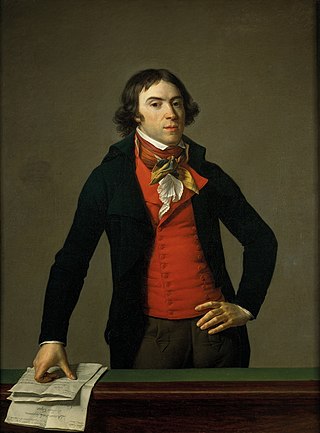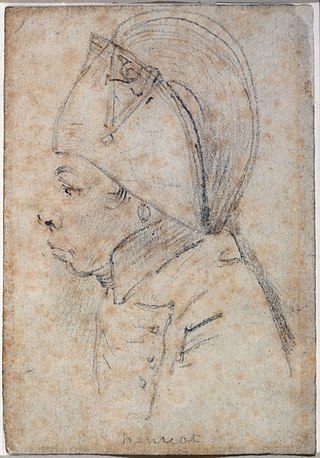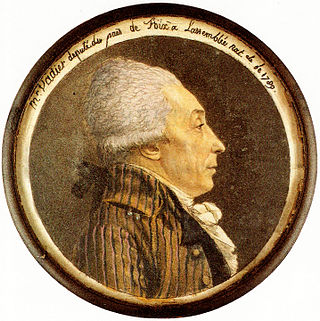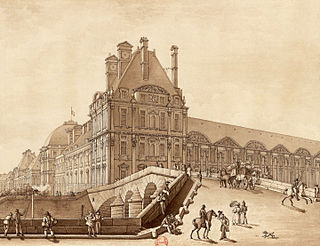Related Research Articles

The Reign of Terror was a period of the French Revolution when, following the creation of the First Republic, a series of massacres and numerous public executions took place in response to revolutionary fervour, anticlerical sentiment, and accusations of treason by the Committee of Public Safety.

Bertrand Barère de Vieuzac was a French politician, freemason, journalist, and one of the most prominent members of the National Convention, representing the Plain during the French Revolution. The Plain was dominated by the radical Montagnards and Barère as one of their leaders supported the foundation of the Committee of Public Safety in April and of a sans-culottes army in September 1793. According to Francois Buzot, Barère was responsible for the Reign of Terror, like Robespierre and Louis de Saint-Just. In spring 1794 and after the Festival of the Supreme Being, he became an opponent of Maximilien Robespierre and joined the coup, leading to his downfall.

Georges Jacques Danton was a leading figure in the French Revolution. A modest and unknown lawyer on the eve of the Revolution, Danton became a famous orator of the Cordeliers Club and was raised to governmental responsibilities as the French Minister of Justice following the fall of the monarchy on the tenth of August 1792, and was allegedly responsible for inciting the September Massacres. He was tasked by the National Convention to intervene in the military conquest of Belgium led by French General Dumouriez. And in the Spring of 1793, he supported the foundation of a Revolutionary Tribunal and became the first president of the Committee of Public Safety.

The Society of the Friends of the Constitution, renamed the Society of the Jacobins, Friends of Freedom and Equality after 1792 and commonly known as the Jacobin Club or simply the Jacobins, was the most influential political club during the French Revolution of 1789. The period of its political ascendancy includes the Reign of Terror, during which well over 10,000 people were put on trial and executed in France, many for political crimes.

The Society of the Friends of the Rights of Man and of the Citizen, mainly known as Cordeliers Club, was a populist political club during the French Revolution from 1790 to 1794, when the Reign of Terror ended and the Thermidorian Reaction began.

The Mountain was a political group during the French Revolution. Its members, called the Montagnards, sat on the highest benches in the National Convention. The term, first used during a session of the Legislative Assembly, came into general use in 1793. By the summer of 1793, that pair of opposed minority groups divided the National Convention. That year, the Montagnards were influential in what is commonly known as the Reign of Terror.

Jacques-Nicolas Billaud-Varenne, also known as Jean Nicolas or by his nicknames, the Righteous Patriot or the Tiger, was a French lawyer and a major figure in the French Revolution. A close associate of Georges Danton and Maximilien Robespierre, he was one of the most militant members of the Committee of Public Safety, and is often considered a key architect of the Reign of Terror.

Jean-Lambert Tallien was a French politician of the revolutionary period. Though initially an active agent of the Reign of Terror, he eventually clashed with its leader, Maximilien Robespierre, and is best known as one of the key figures of the Thermidorian Reaction that led to the fall of Robespierre and the end of the Terror.

Charles-Gilbert Romme was a French politician and mathematician who developed the French Republican Calendar.

François Hanriot was a French Sans-culotte leader, street orator, and commander of the National Guard during the French Revolution. He played a vital role in the Insurrection of 31 May – 2 June 1793 and subsequently the fall of the Girondins. On 27 July 1794 he tried to release Maximilien Robespierre, who was arrested by the Convention. He was executed on the next day – together with Robespierre, Saint-Just and Couthon – by the rules of the law of 22 Prairial, only verifying his identity at the trial.
The Hébertists, or Exaggerators were a radical revolutionary political group associated with the populist journalist Jacques Hébert, a member of the Cordeliers club. They came to power during the Reign of Terror and played a significant role in the French Revolution.

Marc-Guillaume Alexis Vadier was a major French politician of the French Revolution. He is sometimes called the "Great Inquisitor", for his active participation in the Reign of Terror.
During the French Revolution, modérantisme or the faction des modérés was the name the Montagnards gave to their relatively more moderate opponents, first the Girondins and then the Dantonists. Modérantisme was denounced before the Jacobin and the Cordeliers clubs, who then led the first attacks on it in 1794.

Maximilien François Marie Isidore de Robespierre was a French lawyer and statesman, widely recognized as one of the most influential and controversial figures of the French Revolution. Robespierre fervently campaigned for the voting rights of all men and their unimpeded admission to the National Guard. Additionally he advocated for the right to petition, the right to bear arms in self-defence, and the abolition of the Atlantic slave trade.

Martial Joseph Armand Herman (guillotined), was a lawyer and a chief judge during the Reign of Terror. His most famous cases were against Marie Antoinette and Georges Danton. As the commissioner of police, he dealt with the Luxembourg prison conspiracies, shortly before the Jacobin regime fell.

Joachim Vilate, also known as Sempronius-Gracchus Vilate was a French revolutionary figure. The Committee of Public Safety appointed him as member of the jury (juror) of the Revolutionary Tribunal.

Pierre Louis Bentabole was a French revolutionary and statesman, born in Landau Haut Rhin on 4 June 1756 and died in Paris on 22 April 1798. As a lawyer, he presided and practiced in the districts Hagenau and Saverne; he was appointed as the deputy of the Bas-Rhin to the National Convention on 4 September 1792; he voted to execute Louis XVI during his service. On 6 October 1794, he was appointed to the Committee of Public Safety.
Claude-Jean-François Despréaux was a French musician and revolutionary, born in the 1740s and died in Paris on 11 August 1794.
René-François Dumas, born 14 December 1753 in Jussey, in the bailiwick of Amont, was a revolutionary French lawyer and politician, regarded as a "Robespierrist", who died on 28 July 1794 at Paris.
References
- ↑ Frédéric Masson, Le Département des affaires étrangères pendant la révolution, 1787-1804, E. Plon et cie, 1877, p. 286, et Auguste Philippe Herlaut, Le colonel Bouchotte, ministre de la guerre en l'an II, 1946, p. 70.
- ↑ Annuaire historique pour l'année 1850, Société de l'histoire de France, Paris, Jules Renouard et Cie, 1849, p. 158.
- ↑ Auguste Philippe Herlaut, Le colonel Bouchotte, ministre de la guerre en l'an II, 1946, p. 70.
- ↑ see, Noël Parfait, "Notice biographique" in A.-F. Sergent, graveur en taille-douce, 1848, pp. 76-77.
- ↑ Philippe Buchez et Roux, Histoire parlementaire de la Révolution française, volume XVII, pp. 432-433.
- ↑ See the text in Alexandre Sorel, Le Couvent des Carmes et le séminaire de Saint-Sulpice pendant la Terreur, Paris, Didier & Cie, 1864, pp. 364-370
- ↑ Barthélémy Maurice, Histoire des prisons, 1840. see Frédéric Masson, Le Département des affaires étrangères pendant la révolution, 1787-1804, E. Plon et cie, 1877, 570 pages, p. 287.
- ↑ Miot de Mélito, Mémoires, 1858, volume I.
- ↑ "Club des Cordeliers - Séance du 14 ventôse an II (4 mars 1794)" (in French). Archived from the original on 2011-07-27. Retrieved 2010-02-04.
- ↑ Moncure Daniel Conway, Thomas Paine (1737-1809) et la révolution dans les deux mondes, Plon, 1900, p. 345.
- ↑ see the letter in Papiers inédits trouvés chez Robespierre, Saint-Just, Payan, etc., supprimés ou omis par Courtois précédés du rapport de ce député à la Convention nationale, Paris, Baudoin frères, 1828, tome II, pp. 189-193